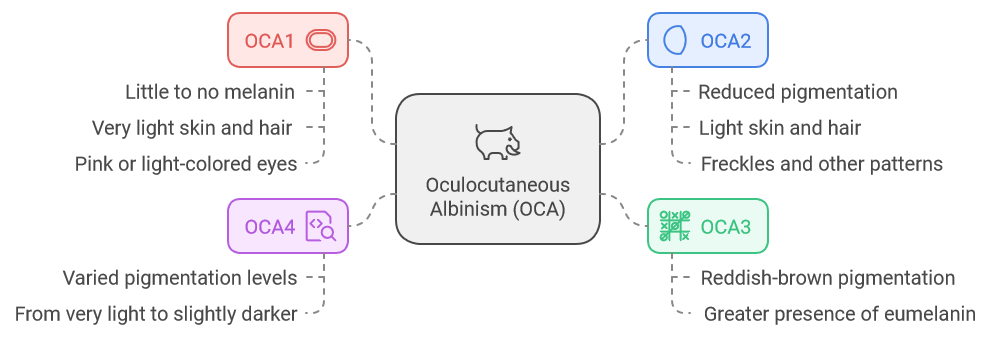Albinism is a genetic condition characterized by a significant lack of melanin, the pigment responsible for the color of our skin, hair, and eyes. Individuals with albinism may exhibit very light skin and hair, and their eyes can appear pink or blue due to the reduced pigmentation. This condition arises from specific genetic mutations that disrupt the normal production of melanin, leading to various degrees of pigmentation and related visual impairments.
Understanding the causes of albinism is crucial for several reasons. First, it helps demystify the condition, reducing stigma and misinformation surrounding those affected. Second, recognizing the genetic basis of albinism allows for better education and awareness of the associated health risks, such as increased susceptibility to sunburn and skin cancers. Finally, understanding albinism can guide families and individuals in making informed choices about protective measures and healthcare.
1. Genetic Basis of Albinism
Albinism is primarily inherited in an autosomal recessive manner, meaning that an individual must inherit two copies of the mutated gene—one from each parent—to manifest the condition. This genetic inheritance pattern highlights the importance of both parents being carriers of the mutated gene, even if they do not show symptoms of albinism themselves.
Several key genes are associated with albinism:
- TYR (Tyrosinase): This gene plays a crucial role in the production of tyrosinase, an enzyme that catalyzes the first step in melanin synthesis. Mutations in the TYR gene can lead to Oculocutaneous Albinism Type 1 (OCA1), where individuals may have little to no melanin production, resulting in very light skin and hair.
- OCA2: The OCA2 gene encodes a protein involved in the transport of compounds necessary for melanin production. Mutations in this gene are linked to Oculocutaneous Albinism Type 2 (OCA2), characterized by reduced pigmentation and, in some cases, the presence of freckles or slightly darker hair.
- TYRP1: This gene provides instructions for a protein that contributes to melanin production, particularly eumelanin, which is the darker form of melanin. Mutations in the TYRP1 gene can lead to variations in skin and hair color within the albinism spectrum, resulting in different degrees of pigmentation.
- SLC45A2: Associated with a subtype of OCA, mutations in the SLC45A2 gene affect the transport of molecules important for melanin synthesis. This gene plays a role in the overall function of melanin-producing cells.
- X-Linked Ocular Albinism (OA): This form is primarily caused by mutations in the GPR143 gene. It mainly affects the eyes, leading to visual impairments, with minimal effects on skin and hair pigmentation. This inheritance pattern is X-linked, meaning it predominantly affects males, as they have only one X chromosome.

2. Types of Albinism
Albinism can be categorized into several distinct types based on the affected genes and the resulting phenotypes. The primary categories include Oculocutaneous Albinism (OCA) and Ocular Albinism (OA).
Oculocutaneous Albinism (OCA)
Oculocutaneous Albinism affects the skin, hair, and eyes. It is the most common form of albinism and is further divided into several subtypes:
- OCA1: Caused by mutations in the TYR gene, individuals with OCA1 typically have little to no melanin production. This leads to very light skin and hair, and they may have pink or light-colored eyes due to the lack of pigmentation in the iris. OCA1 is often characterized by an absence of pigmentation throughout the body.
- OCA2: This subtype is linked to mutations in the OCA2 gene. Individuals with OCA2 usually have reduced pigmentation, which can result in light skin and hair, though they may have some color in their hair and eyes. This type often leads to the development of freckles and other pigmentation patterns.
- OCA3: Associated with mutations in the TYRP1 gene, OCA3 can result in reddish-brown pigmentation. Individuals with this type may have a slightly darker appearance compared to OCA1 and OCA2, with a greater presence of eumelanin.
- OCA4: Linked to mutations in the SLC45A2 gene, OCA4 is similar to OCA2 but may present different pigmentation levels. Individuals with OCA4 can have a range of pigmentation from very light to slightly darker than typical OCA individuals.
Ocular Albinism (OA)
Ocular Albinism primarily affects the eyes and is characterized by reduced pigmentation in the retina. The most common form, X-Linked Ocular Albinism (OA), is caused by mutations in the GPR143 gene. This form generally leads to significant visual impairments, such as reduced visual acuity and sensitivity to light, while the skin and hair may have normal pigmentation levels. Individuals with OA often experience issues with depth perception and may have nystagmus (involuntary eye movements).
3. Phenotypic Expression
The expression of albinism varies significantly among individuals, influenced by genetic mutations and environmental factors.
Variability in Albinism Expression
Not all individuals with albinism exhibit the same degree of pigmentation or associated symptoms. Some may have nearly complete absence of melanin, while others might have slightly pigmented skin or hair. This variability can be attributed to different combinations of mutations in the genes involved in melanin production.
Factors Influencing Phenotypic Outcomes
Several factors contribute to the phenotypic outcomes in individuals with albinism:
- Genetic Mutations: The specific genes that are mutated and the nature of these mutations play a crucial role in determining the extent of pigmentation and the presence of associated health issues.
- Environmental Factors: Exposure to sunlight and other environmental elements can influence how albinism manifests. For example, UV exposure can exacerbate skin sensitivity and increase the risk of sunburn or skin cancer in individuals with albinism.
Discussion of Pigmentation Levels in Individuals
Pigmentation levels in individuals with albinism can range widely. For instance, someone with OCA1 might appear almost completely white, while another person with OCA3 might have a reddish-brown hue. These variations can impact not only appearance but also the quality of life, as individuals with less pigmentation may face greater challenges related to sun sensitivity and vision. Understanding these variations is essential for providing appropriate care and support to individuals with albinism.
4. Environmental Factors
Individuals with albinism face significant challenges due to their lack of melanin, which provides natural protection against harmful ultraviolet (UV) radiation from the sun. The environmental influences on people with albinism can lead to various health risks, particularly concerning skin and eye health.
Impact of Environmental Influences on Individuals with Albinism
Due to their reduced melanin levels, individuals with albinism are more susceptible to the harmful effects of UV exposure. Melanin plays a critical role in absorbing UV radiation and protecting the skin from damage. As a result, people with albinism often experience heightened sensitivity to sunlight, leading to discomfort and increased likelihood of skin-related issues.
Increased Risk of Sunburn and Skin Cancers
The absence of adequate melanin significantly elevates the risk of sunburn in individuals with albinism. Even brief exposure to sunlight can result in painful burns. Moreover, the lack of protective pigmentation increases their risk of developing skin cancers, including basal cell carcinoma, squamous cell carcinoma, and melanoma. Regular skin examinations are essential for early detection and management of any changes that may indicate skin cancer.
Importance of Protective Measures
To mitigate these risks, individuals with albinism must adopt several protective measures:
- Use of Sunscreen: Applying broad-spectrum sunscreen with a high SPF (30 or above) is crucial. Sunscreen should be applied generously to all exposed skin, and it should be reapplied every two hours, or more often if swimming or sweating.
- Protective Clothing: Wearing long-sleeved shirts, long pants, and wide-brimmed hats can help shield the skin from UV rays. Clothing made from tightly woven fabric offers better protection, and some garments are specifically designed with UV protection features.
- Sunglasses: Protecting the eyes is equally important. High-quality sunglasses that block 100% of UVA and UVB rays can help prevent damage to the eyes and reduce the risk of vision issues commonly associated with albinism, such as light sensitivity and photophobia.
Conclusion
In summary, albinism is primarily a genetic condition characterized by a lack of melanin, leading to various types and degrees of pigmentation differences among affected individuals. Understanding the genetic basis and types of albinism is vital for raising awareness and providing appropriate support to those affected. Moreover, recognizing the importance of protective measures against environmental risks, such as UV exposure, can significantly improve the quality of life for individuals with albinism and help them lead healthier lives.
Resources for Further Reading
- National Organization for Albinism and Hypopigmentation (NOAH)
- Genetics Home Reference (MedlinePlus)
- The American Academy of Dermatology
- National Institutes of Health (NIH)
FAQs About Albinism
1. What is albinism?
Albinism is a genetic condition characterized by a lack of melanin, the pigment responsible for coloring skin, hair, and eyes. It can lead to various degrees of pigmentation differences and associated health challenges, particularly concerning vision and skin health.
2. What causes albinism?
Albinism is primarily caused by genetic mutations that affect melanin production. It is inherited in an autosomal recessive manner, meaning an individual must inherit two copies of a mutated gene (one from each parent) to manifest the condition. Key genes involved include TYR, OCA2, TYRP1, SLC45A2, and GPR143.
3. What are the different types of albinism?
There are two main types of albinism:
- Oculocutaneous Albinism (OCA): Affects the skin, hair, and eyes, with several subtypes (OCA1, OCA2, OCA3, OCA4).
- Ocular Albinism (OA): Primarily affects the eyes and is often associated with visual impairments, with X-Linked Ocular Albinism being the most common form.
4. How does albinism affect vision?
Individuals with albinism often experience vision problems, including reduced visual acuity, light sensitivity (photophobia), and issues with depth perception. These vision-related challenges are particularly prominent in those with ocular albinism.
5. What are the health risks associated with albinism?
Due to the lack of melanin, individuals with albinism are at a higher risk for sunburn and skin cancers. It is crucial for them to take protective measures, such as using sunscreen, wearing protective clothing, and using sunglasses to mitigate these risks.
6. Can people with albinism tan?
Individuals with albinism typically cannot tan due to their lack of melanin. Their skin remains sensitive to UV exposure, which increases the risk of sunburn and skin damage.
7. What protective measures should individuals with albinism take?
To protect themselves from the harmful effects of UV radiation, individuals with albinism should:
- Use broad-spectrum sunscreen with a high SPF.
- Wear protective clothing, such as long-sleeved shirts and wide-brimmed hats.
- Use sunglasses that block 100% of UVA and UVB rays.
8. Is there a cure for albinism?
Currently, there is no cure for albinism, as it is a genetic condition. However, supportive measures, such as regular eye examinations and protective strategies against sun exposure, can help manage symptoms and improve quality of life.
9. How can I support someone with albinism?
Support can include raising awareness about albinism, providing emotional support, and encouraging protective measures to safeguard their health. Understanding the challenges they face and advocating for inclusivity in various settings can also make a significant difference.
